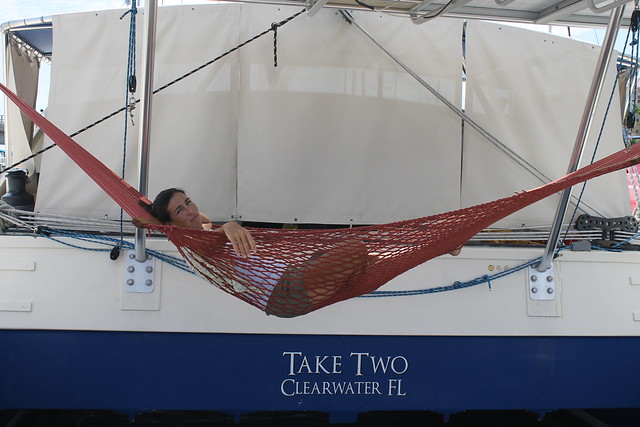I’ve been a mom for almost ten years now, and have familiarity with—and sometimes intimate knowledge of—a lot of baby gear. Much of it, I have come to realize, is extraneous and some borderline ridiculous. As we have streamlined our lives I have had to reassess things I thought were “needs” and re-categorize them as “wants.” Need, I used to tell my kindergarten students, involves dying if you don’t get it. For a newborn, needs are relatively few: they need food, a safe place to sleep, a safe/easy way to travel, a clean diaper, and someone to cuddle with.
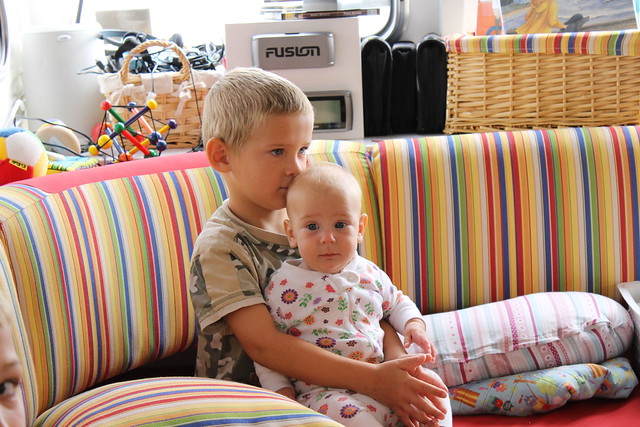
Our baby is lucky—she has six people to cuddle with, so we can check that one off the list. (I do, however, highly recommend getting a seven year old girl if you have a newborn around as they are very helpful. Sarah has some cuddle time every morning with Rachel while I am making breakfast.)¬ As we are firm believers that “breast is best,” we can check food off the list, too. I will note that my favorite nursing bras are the Bravado bras ($30) and that a Boppy pillow ($30), though not necessary, does come in handy. Where to put it on a boat is another question entirely.
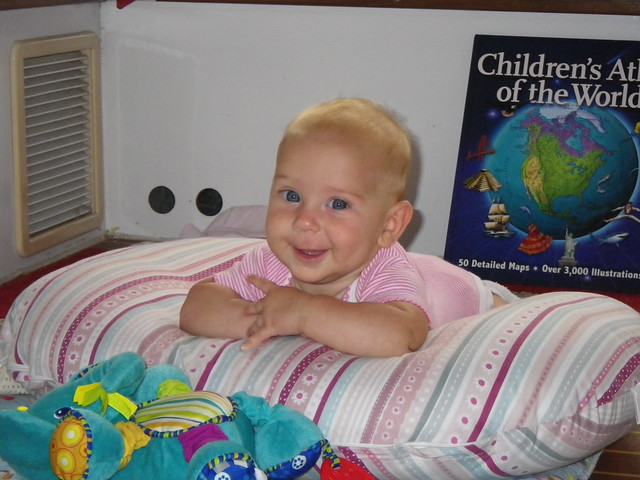
As for a safe place to sleep, we have had a crib built into a single berth in one of the hulls, but for the first weeks aboard, Rachel has been sleeping in our berth, at the foot of our bed in a straw “Moses” basket that was woven for her in the Bahamas. We love the basket, but it has limited usefulness because babies grow so fast—by the time she is five months old, she’ll be too big and also able to roll out of it. On the other hand, having a mobile bed is great—she has taken several naps in the shade up by the pool, and in the cockpit. It sure beats a large and unwieldy playpen/folding crib like the Pack n’ Play that we used for the other children. I can recommend a basket ($40-$80), but it will have to be stored somewhere after it has become obsolete. The crib, incidentally, is perfect and we are really happy—it will break down easily for access to the compartments underneath, and the end of the crib is removable to make the sleeping space available for a toddler or larger child.
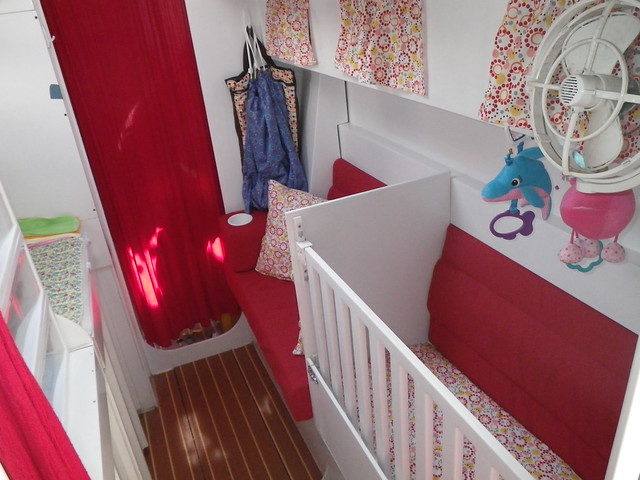
For safe and easy travel, I can recommend two things: the best stroller I have ever found, the Chicco Liteway Stroller ($140), and the best baby carrier, the Ergo ($115). Having had four strollers at one point when we lived in the house (a travel system, an umbrella stroller, a double stroller, and a universal stroller for transferring a car seat without disturbing the baby) and having used virtually every kind of baby carrier, I feel pretty confident in using the word best. The Chicco Liteway can be lifted, folded and unfolded with one hand (and a foot), fits in our dock box or a lazarette on the boat, reclines for newborn or naptime use, has a five-point harness to keep a toddler in place, has a sunshade, cup holder and storage basket, and is constructed of aluminum, plastic and canvas to make it weather-resistant. What more could I ask? (Maybe a snack tray and rain cover…)
The Ergo is, as the name suggests, ergonomic for mother and baby. Mom bears the weight on her legs (like a frame pack), and the baby’s spine is supported (as opposed to dangling a by the crotch). It works for newborns as well as toddlers up to forty pounds, is washable, compact enough to stuff in a bag, can be fastened by the wearer (without help), has a sunshade and zipper pocket, and can be worn on the front, back, and even hip. I love this thing—I actually walked around Publix last week with a two-week old baby and was able to discreetly nurse her while I shopped—the ultimate in multi-tasking! I can even go to the bathroom without removing the carrier or baby. Because it is so comfortable, I can wear it for hours without a backache. Sam spent a good amount of his infancy in it, and I was able to handle lines and help with docking and anchoring with him on my back! It’s great for dinghy rides, hiking, and beach trips, too. As a bonus, when people make the annoying and repetitive comment, “Boy, you’ve got your hands full!” I just hold up my hands and say, “Actually, I’ve got both hands free!”
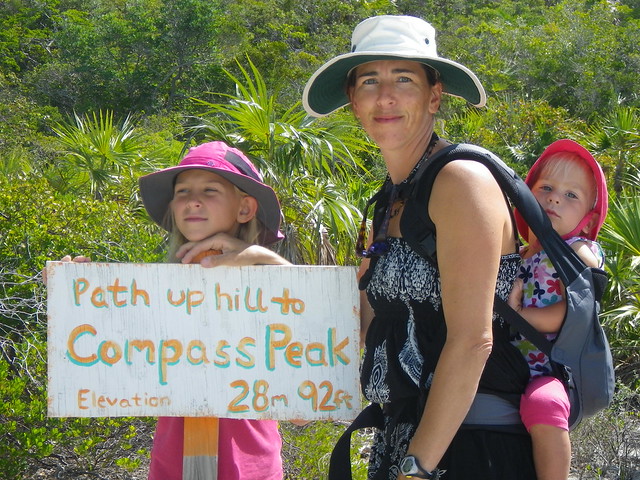
The last item, diapering, is near and dear to my heart, as I have spent eight of the last ten years taking care of small butts. We have always used cloth diapers, even when we lived in the house, because I couldn’t stand the idea that my children’s diapers would probably outlive them if they were made of plastic and buried in a landfill somewhere. Because we live on a boat and travel, buying and storing enough diapers would be difficult to impossible. Cloth is economical, better for the baby and the environment, and encourages earlier potty-training.
For the other four children, we used a brand called Indisposables and I really liked them. They are pre-formed cotton flannel diapers, with thick padding in the middle, elastic legs and waist, and Velcro fasteners. They are used in conjunction with vinyl covers (either waterproof pants or Velcro-closure wraps) and flannel wipes. They cost about $300 and last on average 2 ½ children, assuming two years of use per kid. They were falling apart by the time Sam arrived, so we bought new ones. They can be washed and hung to dry, and don’t require folding. For Rachel, I was looking for similar diapers, but wanted something that would dry faster and look more innocuous on the lifelines. I found a great deal on a starter kit: the Bummis Organic Cotton Diaper Kit ($170), which came with two dozen tri-fold flat diapers, six waterproof Velcro-fastener covers, a waterproof hanging bag (to use as a washable diaper pail), polyester liners for nap/night time use, and other assorted accessories. I love them, and they do dry faster, spending less time on the lifelines. I have to do a load every day or two, but as we now have a washer/dryer on the boat, it’s no big deal. There is a third kind of diaper which I have not tried, an all-in-one where the waterproof cover has a cotton liner, and is fully adjustable for newborn-through-toddler size—but my sister-in-law is sending me some, so I’ll have write later about those. For now, the Bummis are working great and seem to be ideal for a boating family with a baby.
Needless to say, we are enjoying our new crew member immensely. She is a joy to be around and sleeps like, well, a baby. I’m also loving the new baby stuff—it seems like I have finally figured out after five kids how to identify gear that makes sense and gives me a lot of bang for my buck. If I’m not an expert by now, I guess I never will be.

